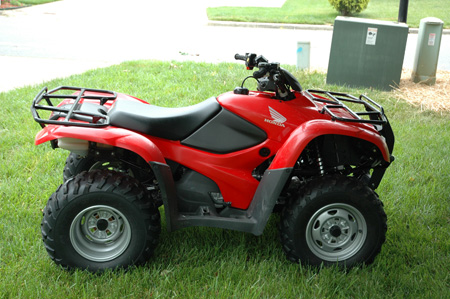ATV Accident Reconstruction
Need to speak to an engineer? Contact our team today.
Since 2003, Gary E. Kilpatrick, PE, DFE at The Kilpatrick Group, P.A. has been a service provider of ATV/AATV/ROV/UTV crash reconstruction and product defect and failure analyses to our legal and insurance clients. Gary is a mechanical design engineer, a licensed Professional Engineer, and he is a board certified Diplomat Forensic Engineer (DFE) through the National Academy of Forensic Engineers (NAFE). He has extensive engineering education, training, skill and experience in ATV/ROV/AATV crash reconstruction and product defect and failure analyses. He holds ATV and ROV rider’s certifications through both the ATV Safety Institute and The Recreational Off-Highway Vehicle Association. Gary has studied the sciences of vehicle crash reconstruction and has certifications through Northwestern University’s Center For Public Safety in motor vehicle crash reconstruction. Gary has owned and operated a Honda TRX 420 Rancher All-Terrain Vehicle and has been an avid ATV rider for many years and is an ATV/ROV/AATV crash reconstruction, product defect and failure and safety expert. Gary travels throughout the United States to investigate motorcycle crashes, product defect and failure claims resulting in personal injury or wrongful death.
During 1990, the Specialty Vehicle Institute of America (SVIA) with the assistance of the American National Standards Institute (ANSI) published the first standard for ATVs referred to as ANSI/SVIA-1-1990. During 2001, ANSI/SVIA revised this standard referred to as standard ANSI/SVIA 1-2001. The standard was revised again during 2007 and again in 2010 and is referred to as standard ANSI/SVIA 1-2010. According to the standard ANSI/SVIA-1-1990, an All Terrain Vehicle (ATV) is any motorized off-highway vehicle 50 inches or less in overall width with an unladen dry weight of 600 pounds or less designed to travel on four low pressure tires having a seat designed to be straddled by the operator and handlebars for steering control and intended for use by a single operator and no passenger. Width and weight is exclusive of accessories and optional equipment. ATVs are subdivided into four categories as follows:
- Category G (General Use Model): An ATV intended for general recreational and utility use.
- Category S (Sport Model): An ATV intended for recreational use by experienced operators only.
- Category U (Utility Model): An ATV intended primarily for utility use.
- Category Y (Youth Model): An ATV intended for recreational off-road use under adult supervision by operators under age 16.
Youth model ATVs can further be categorized as follows:
- Category Y-6: A Category Y-6 ATV is a youth model ATV which is intended for use by children age 6 and older.
- Category Y-12: A Category Y-12 ATV is a youth model ATV which is intended for use by children age 12 and older.
ATV’s are straddled and sat on by an operator similarly to a motorcycle. The ATV is controlled utilizing a handle bar for steering, a throttle thumb lever for engine/vehicle speed control, hand levers for the brake and clutch, foot peddle for brakes, a foot gear shifter or hand shifter to change the transmission gears and foot pegs and/or running boards as foot rests.
The first ATVs were introduced to the American marketplace during the 1950’s. These early models utilized a six wheel design and are referred to as an AATV which means Amphibious All Terrain Vehicle. The AATV’s were designed to float and propel themselves on water and could maneuver through swamps and creeks.
According to the Specialty Vehicle Institute of America (SVIA), the first recreational ATV to be introduced into the American marketplace was by Honda during 1970 and was called the ATC90 and was a three wheeler that had one forward wheel for steering and two rear drive wheels for propulsion. Soon after, Yamaha, Kawasaki and Suzuki follows with their 3-wheeled versions. The first four-wheel recreational ATV was introduced to the American marketplace by Honda during 1984 called the TRXTM 200.
We provide the following forensic engineering services for ATV accidents:
- ATV Accident Reconstruction
- Preimpact and Postimpact Velocities
- Delta-V Calculations
- Vehicle Principle Direction of Force (PDOF) Calculations
- Vehicle Energy Calculations
- Acceleration, Distance, Time Calculations
- Road/Tire Coefficient of Friction/Drag Factor Measurement and Calculations
- Angular Momentum, Rotational Energy and Rotational Motion Calculations
- Critical Velocity and Yaw Calculations
- Vehicle Falls, Flips and Vault Airborne Calculations
- Vehicle Rollover Analysis and Calculations
- Vehicle Dynamic Weight Shift Calculations
- Vehicle Low Velocity Rear-End Collisions Analysis and Calculations
- Vehicle Trajectory
- Cause Analysis
- Human Factors
- Vehicle Inspections For Defects and Non-Conformance
- Product Defect and Failure Analysis
- Catastrophic Component Failure Determination
- ATV Safety
- Standard of Care
Gary is an avid ATV rider. He obtained ATV rider’s training through the ATV Safety Institute. He owns and rides the 2007 Honda Rancher pictured below.

